Balbharti Maharashtra State Board Class 8 History Solutions
Chapter 4 The Freedom Struggle of 1857 Notes, Textbook Exercise Important Questions and Answers.
Class 8 History Chapter 4 The Freedom Struggle of 1857 Textbook Questions and Answers
1. Rewrite the statements by choosing the appropriate options:
(Umaji Naik, War of Independence, Lord Dalhousie, Secretary of State, Tatya Tope)
Question 1.
V. D. Savarkar named the struggleof 1857 as the ………. .
Answer:
War of Independence
Question 2.
……….. united the Ramoshis to rebel against the British.
Answer:
Umaji Naik

Question 3.
After the struggle of 1857, the post of …………. was created in the British Government to look after the affairs of India.
Answer:
Secretary of State
Question 4.
………… was the Governor General who annexed the princely states.
Answer:
Lord Dalhousie.
2. Explain the following statements with reasons :
Question 1.
The Paikas made armed rebellion against the British.
Answer:
This resulted in armed rebellion of the Paikas against the British in 1817.
Question 2.
There was discontent among the Hindu and Muslim sepoys.
Answer:
Question 3.
The Indian sepoys could not keep stand in front of the British army.
Answer:
The Indian sepoys could not keep stand in front of the British army because :
This proved that the wars are not fought only on bravery but also through military strategies.

Question 4.
After the struggle, Indian army was divided on the basis of caste.
Answer:
There was division of military on the basis of caste because :
Question 5.
The British imposed heavy taxes on Indian industries.
Answer:
3. Answer the following questions in brief:
Question 1.
What were the social causes behind the struggle of 1857?
Answer:
The social causes behind the struggle of 1857 were :
Question 2.
Why did the Indians fail in the struggle of 1857?
Answer:
There are several reasons for the failure of Indians in the struggle of 1857. They were :

Question 3.
What were the consequences of struggle of 1857?
Answer:
Question 4.
What were the changes in British policy after the struggle of 1857?
Answer:
Project:
Question 1.
Search for the book written by V. D. Savarkar entitled ‘The Indian War of Independence 1857’ and read it.
Question 2.
On an outline map of India indicate the regions where the freedom struggle of 1857 took place.
Class 8 History Chapter 4 The Freedom Struggle of 1857 Additional Important Questions and Answers
Identify the wrong pair, correct it and rewrite:
Question 1.
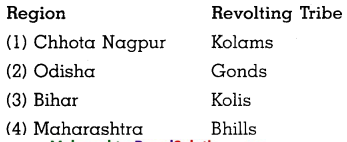
Answer:
Wrong pair: Bihar – Kolis
Corrected pair: Bihar – Santhals.
Name the following:
Question 1.
Led the revolt of Paikas:
Answer:
Bakshi Jaganbandhu Bidyadhar
Question 2.
Last Mughal Emperor of Delhi:
Answer:
Bahadur Shah

Question 3.
Led the revolt of Bhills in Khandesh:
Answer:
Kajarsingh
Question 4.
Led the revolt in Satpura:
Answer:
Shankarshah
Rewrite the statements by choosing the appropriate options:
Question 1.
In 1806, Indian soldiers at …………. revolted.
(a) Barrackpore
(b) Meerut
(c) Vellore
(d) Delhi
Answer:
(c) Vellore
Question 2.
Governor General …………… annexed many states through Doctrine of Lapse.
(a) Lord Warren Hastings
(b) Lord Cornwallis
(c) Lord Canning
(d) Lord Dalhousie
Answer:
(d) Lord Dalhousie
Question 3.
Bahadur Shah who led the revolt was imprisoned at …………… .
(a) Nepal
(b) Rangoon
(c) Sri Lanka
(d) Andaman
Answer:
(b) Rangoon
Question 4.
………… fought for ten months against British but was caught due to betrayal.
(a) Rango Bapuji
(b) Bakht Khan
(c) Tatya Tope
(d) Ahmedullah
Answer:
(c) Tatya Tope

Answer the following questions in one sentence:
Question 1.
Why did the Indian sepoys at Meerut rebel against the British?
Answer:
When the news that Mangal Pandey was arrested and hanged reached Meerut cantonment, the entire regiment of the Indian sepoys rebelled against the British.
Question 2.
In which parts of North India did the revolt spread?
Answer:
After Delhi, the revolt spread in Lucknow, Allahabad, Kanpur, Banaras, Bareli and Jhansi.
Question 3.
Who fought the Crimean War?
Answer:
The Crimean war was fought between Britain and Russia.
Question 4.
Which policy did the British adopt to pollute the minds of Indians?
Answer:
The British adopted the policy of ‘Divide and Rule’ to pollute the minds of the Indians.
Complete the graphical presentation:
Question 1.
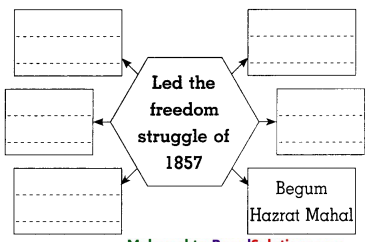
Answer:
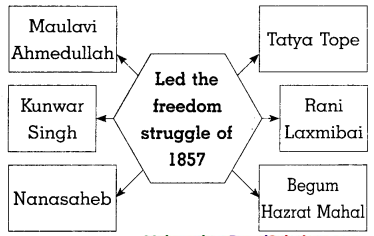
Question 2.
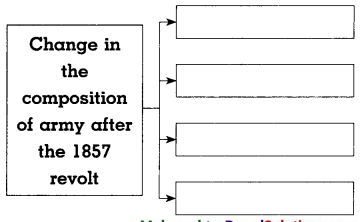
Answer:
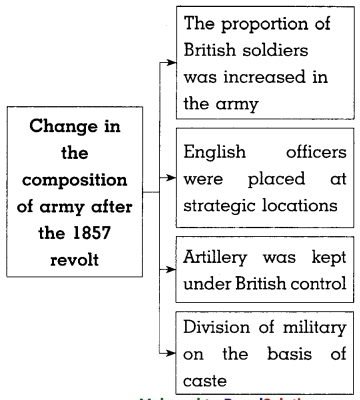
Question 3.
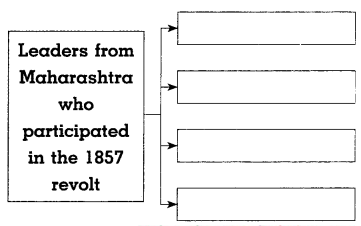
Answer:
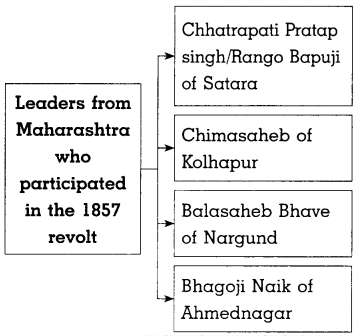
Write Short Notes :
Question 1.
Paika Rebellion:
Answer:

Question 2.
Rebellion of Umaji Naik:
Answer:
1. Exploitation was on a large scale during the Company’s rule in India. There was rising discontent among the Indians. Sanyasis-Fakirs rebelled in the | Bengal province.
2. Umaji Naik organised the Ramoshis and the local youth and gave a strong fight to the British in Maharashtra.
3. They drafted a declaration and appealed to the people to support them in their fight against to overthrow the British government.
4. People in Ahmednagar, Satara, Pune, Nasik, Solapur and Bhor were inspired by them.
5. Umaji Naik was arrested and hanged to death in 1832 at Pune.
Explain the following statements with reasons:
Question 1.
There was discontent among the Indian soldiers.
Answer:
Question 2.
Mangal Pandey was arrested and hanged.
Answer:

Answer the following questions in brief :
Question 1.
What changes were made in administration of India after the struggle of 1857?
Answer:
After the struggle of 1857, the British Parliament made the following changes in the administration of India :
Question 2.
Write about Queen’s Proclamation.
Answer:
Read the given passage and answer the questions given below :
Questions :
Question 1.
Name the leaders of the struggle who lost their lives on the battlefield.
Answer:
Rani Laxmibai, Kunwar Singh, Ahmedullah laid their lives on the battle field.
Question 2.
Who was hanged to death?
Answer:
Tatya Tope fought for ten months but was caught by betrayal and hanged to death.
Question 3.
Which leaders took shelter in Nepal?
Answer:
Nanasaheb Peshwa and Begum Hazrat Mahal took shelter in Nepal.

Answer the following questions in detail :
Question 1.
Explain the reasons of the struggle of 1857 with following points :
(1) Economic
(2) Political
Answer:
The reasons of 1857 freedom struggle :
Economic :
Political :
All these factors created discontent among artisans, princes and other classes f which ultimately led to the freedom struggle of 1857.
Question 2.
Write about the struggles before 1857.
Answer:
There was rising discontent among the Indians which led to many struggles before 1857 :
Question 3.
How did the scope of the struggle increase?
Answer:
1. Mangal Pandey shot a British officer at Barrackpore cantonment who forced him to use cartridges greased with the fat of cows and pigs.
2. Mangal Pandey was arrested and hanged. News spread like fire to other cantonments.
3. The entire regiment of Indian soldiers at Meerut battled and marched towards Delhi.
4. On reaching Delhi, the rebels proclaimed Bahadur Shah as the Emperor of India.
5. It spread to the whole of north India. The soldiers in the cantonments from Bihar to Rajput ana participated in the revolt.
6. The revolt spread to Lucknow, Allahabad, Kanpur, Banaras, Bareli and Jhansi.
7. It spread to the whole of north India and in Nagpur, Satara, Kolhapur and Nargund, Khandesh in western India.
8. Many princely states, peasants and about 400 female Bhills participated in revolt at Khandesh to free themselves from the oppressive rule of the British.
9. The struggle was led by Bahadur Shah the Mughal Emperor, Nanasaheb Peshwa, Rani Laxmibai, Tatya Tope, Kunwar Singh of Bihar and Begum Hazrat Mahal of Ayodhya.

Question 4.
Why did the struggle fail?
Answer:
The reasons for the failure are as follows :
1. The struggle remained limited to the Northern part and it did not spread all over India at the same time.
2. Its intensity was severe in North India but Rajputana, Punjab but parts of Bengal and North-west India remained aloof.
3. Many princely states remained loyal to the British which reduced its intensity.
4. The majority of the rulers of the Indian states and the educated Indians kept away from the struggle.
5. Though the soldiers were brave they did not use military tactics.
6. As there was no commonly accepted leader to fight the British, there was no uniformity of the struggle.
7. On the other hand, the British had economic strength, experienced generals, disciplined army, latest weapons and modern means of transport and communication which made movements of the British swift.
8 The naval strength of the British was vast, while rebels were isolated.
Question 5.
What lesson have we learnt from the struggle of 1857?
Answer:
We learnt the following lesson from the struggle of 1857 :
1. Any challenge in front of the nation should be faced unitedly.
2. Each and every member of the society should keep in mind that if two people or groups disagree or have difference in opinion there are chances of third party creating misunderstanding and taking advantage of it. We need to be careful with such tendencies.
3. If the means to earn livelihood is taken away it creates discontent. Therefore, all should get means to earn livelihood.
4. The division in army, government offices and business should not be based on caste, race and religion. It should be based on merit and equality.
Chapter 4 The Freedom Struggle of 1857 Notes, Textbook Exercise Important Questions and Answers.
Class 8 History Chapter 4 The Freedom Struggle of 1857 Textbook Questions and Answers
1. Rewrite the statements by choosing the appropriate options:
(Umaji Naik, War of Independence, Lord Dalhousie, Secretary of State, Tatya Tope)
Question 1.
V. D. Savarkar named the struggleof 1857 as the ………. .
Answer:
War of Independence
Question 2.
……….. united the Ramoshis to rebel against the British.
Answer:
Umaji Naik

Question 3.
After the struggle of 1857, the post of …………. was created in the British Government to look after the affairs of India.
Answer:
Secretary of State
Question 4.
………… was the Governor General who annexed the princely states.
Answer:
Lord Dalhousie.
2. Explain the following statements with reasons :
Question 1.
The Paikas made armed rebellion against the British.
Answer:
This resulted in armed rebellion of the Paikas against the British in 1817.
Question 2.
There was discontent among the Hindu and Muslim sepoys.
Answer:
Question 3.
The Indian sepoys could not keep stand in front of the British army.
Answer:
The Indian sepoys could not keep stand in front of the British army because :
This proved that the wars are not fought only on bravery but also through military strategies.

Question 4.
After the struggle, Indian army was divided on the basis of caste.
Answer:
There was division of military on the basis of caste because :
Question 5.
The British imposed heavy taxes on Indian industries.
Answer:
3. Answer the following questions in brief:
Question 1.
What were the social causes behind the struggle of 1857?
Answer:
The social causes behind the struggle of 1857 were :
Question 2.
Why did the Indians fail in the struggle of 1857?
Answer:
There are several reasons for the failure of Indians in the struggle of 1857. They were :

Question 3.
What were the consequences of struggle of 1857?
Answer:
Question 4.
What were the changes in British policy after the struggle of 1857?
Answer:
Project:
Question 1.
Search for the book written by V. D. Savarkar entitled ‘The Indian War of Independence 1857’ and read it.
Question 2.
On an outline map of India indicate the regions where the freedom struggle of 1857 took place.
Class 8 History Chapter 4 The Freedom Struggle of 1857 Additional Important Questions and Answers
Identify the wrong pair, correct it and rewrite:
Question 1.

Answer:
Wrong pair: Bihar – Kolis
Corrected pair: Bihar – Santhals.
Name the following:
Question 1.
Led the revolt of Paikas:
Answer:
Bakshi Jaganbandhu Bidyadhar
Question 2.
Last Mughal Emperor of Delhi:
Answer:
Bahadur Shah

Question 3.
Led the revolt of Bhills in Khandesh:
Answer:
Kajarsingh
Question 4.
Led the revolt in Satpura:
Answer:
Shankarshah
Rewrite the statements by choosing the appropriate options:
Question 1.
In 1806, Indian soldiers at …………. revolted.
(a) Barrackpore
(b) Meerut
(c) Vellore
(d) Delhi
Answer:
(c) Vellore
Question 2.
Governor General …………… annexed many states through Doctrine of Lapse.
(a) Lord Warren Hastings
(b) Lord Cornwallis
(c) Lord Canning
(d) Lord Dalhousie
Answer:
(d) Lord Dalhousie
Question 3.
Bahadur Shah who led the revolt was imprisoned at …………… .
(a) Nepal
(b) Rangoon
(c) Sri Lanka
(d) Andaman
Answer:
(b) Rangoon
Question 4.
………… fought for ten months against British but was caught due to betrayal.
(a) Rango Bapuji
(b) Bakht Khan
(c) Tatya Tope
(d) Ahmedullah
Answer:
(c) Tatya Tope

Answer the following questions in one sentence:
Question 1.
Why did the Indian sepoys at Meerut rebel against the British?
Answer:
When the news that Mangal Pandey was arrested and hanged reached Meerut cantonment, the entire regiment of the Indian sepoys rebelled against the British.
Question 2.
In which parts of North India did the revolt spread?
Answer:
After Delhi, the revolt spread in Lucknow, Allahabad, Kanpur, Banaras, Bareli and Jhansi.
Question 3.
Who fought the Crimean War?
Answer:
The Crimean war was fought between Britain and Russia.
Question 4.
Which policy did the British adopt to pollute the minds of Indians?
Answer:
The British adopted the policy of ‘Divide and Rule’ to pollute the minds of the Indians.
Complete the graphical presentation:
Question 1.

Answer:

Question 2.

Answer:

Question 3.

Answer:

Write Short Notes :
Question 1.
Paika Rebellion:
Answer:

Question 2.
Rebellion of Umaji Naik:
Answer:
1. Exploitation was on a large scale during the Company’s rule in India. There was rising discontent among the Indians. Sanyasis-Fakirs rebelled in the | Bengal province.
2. Umaji Naik organised the Ramoshis and the local youth and gave a strong fight to the British in Maharashtra.
3. They drafted a declaration and appealed to the people to support them in their fight against to overthrow the British government.
4. People in Ahmednagar, Satara, Pune, Nasik, Solapur and Bhor were inspired by them.
5. Umaji Naik was arrested and hanged to death in 1832 at Pune.
Explain the following statements with reasons:
Question 1.
There was discontent among the Indian soldiers.
Answer:
Question 2.
Mangal Pandey was arrested and hanged.
Answer:

Answer the following questions in brief :
Question 1.
What changes were made in administration of India after the struggle of 1857?
Answer:
After the struggle of 1857, the British Parliament made the following changes in the administration of India :
Question 2.
Write about Queen’s Proclamation.
Answer:
Read the given passage and answer the questions given below :
Questions :
Question 1.
Name the leaders of the struggle who lost their lives on the battlefield.
Answer:
Rani Laxmibai, Kunwar Singh, Ahmedullah laid their lives on the battle field.
Question 2.
Who was hanged to death?
Answer:
Tatya Tope fought for ten months but was caught by betrayal and hanged to death.
Question 3.
Which leaders took shelter in Nepal?
Answer:
Nanasaheb Peshwa and Begum Hazrat Mahal took shelter in Nepal.

Answer the following questions in detail :
Question 1.
Explain the reasons of the struggle of 1857 with following points :
(1) Economic
(2) Political
Answer:
The reasons of 1857 freedom struggle :
Economic :
Political :
All these factors created discontent among artisans, princes and other classes f which ultimately led to the freedom struggle of 1857.
Question 2.
Write about the struggles before 1857.
Answer:
There was rising discontent among the Indians which led to many struggles before 1857 :
Question 3.
How did the scope of the struggle increase?
Answer:
1. Mangal Pandey shot a British officer at Barrackpore cantonment who forced him to use cartridges greased with the fat of cows and pigs.
2. Mangal Pandey was arrested and hanged. News spread like fire to other cantonments.
3. The entire regiment of Indian soldiers at Meerut battled and marched towards Delhi.
4. On reaching Delhi, the rebels proclaimed Bahadur Shah as the Emperor of India.
5. It spread to the whole of north India. The soldiers in the cantonments from Bihar to Rajput ana participated in the revolt.
6. The revolt spread to Lucknow, Allahabad, Kanpur, Banaras, Bareli and Jhansi.
7. It spread to the whole of north India and in Nagpur, Satara, Kolhapur and Nargund, Khandesh in western India.
8. Many princely states, peasants and about 400 female Bhills participated in revolt at Khandesh to free themselves from the oppressive rule of the British.
9. The struggle was led by Bahadur Shah the Mughal Emperor, Nanasaheb Peshwa, Rani Laxmibai, Tatya Tope, Kunwar Singh of Bihar and Begum Hazrat Mahal of Ayodhya.

Question 4.
Why did the struggle fail?
Answer:
The reasons for the failure are as follows :
1. The struggle remained limited to the Northern part and it did not spread all over India at the same time.
2. Its intensity was severe in North India but Rajputana, Punjab but parts of Bengal and North-west India remained aloof.
3. Many princely states remained loyal to the British which reduced its intensity.
4. The majority of the rulers of the Indian states and the educated Indians kept away from the struggle.
5. Though the soldiers were brave they did not use military tactics.
6. As there was no commonly accepted leader to fight the British, there was no uniformity of the struggle.
7. On the other hand, the British had economic strength, experienced generals, disciplined army, latest weapons and modern means of transport and communication which made movements of the British swift.
8 The naval strength of the British was vast, while rebels were isolated.
Question 5.
What lesson have we learnt from the struggle of 1857?
Answer:
We learnt the following lesson from the struggle of 1857 :
1. Any challenge in front of the nation should be faced unitedly.
2. Each and every member of the society should keep in mind that if two people or groups disagree or have difference in opinion there are chances of third party creating misunderstanding and taking advantage of it. We need to be careful with such tendencies.
3. If the means to earn livelihood is taken away it creates discontent. Therefore, all should get means to earn livelihood.
4. The division in army, government offices and business should not be based on caste, race and religion. It should be based on merit and equality.